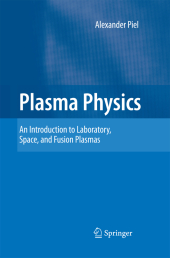 Neuerscheinungen 2014Stand: 2020-02-01 |
Schnellsuche
ISBN/Stichwort/Autor
|
Herderstraße 10
10625 Berlin
Tel.: 030 315 714 16
Fax 030 315 714 14
info@buchspektrum.de |

Alexander Piel
Plasma Physics
An Introduction to Laboratory, Space, and Fusion Plasmas
2010. 2014. xviii, 398 S. 235 mm
Verlag/Jahr: SPRINGER, BERLIN; SPRINGER BERLIN HEIDELBERG 2014
ISBN: 3-642-43631-5 (3642436315)
Neue ISBN: 978-3-642-43631-4 (9783642436314)
Preis und Lieferzeit: Bitte klicken
This book covers all aspects of plasma physics at an introductory level. Coverage develops the fundamental concepts of plasma description in a bottom-up approach of increasing mathematical complexity.
This book is an outgrowth of courses in plasma physics which I have taught at Kiel University for many years. During this time I have tried to convince my students that plasmas as different as gas dicharges, fusion plasmas and space plasmas can be described in a uni ed way by simple models. The challenge in teaching plasma physics is its apparent complexity. The wealth of plasma phenomena found in so diverse elds makes it quite different from atomic physics, where atomic structure, spectral lines and chemical binding can all be derived from a single equation-the Schrödinger equation. I positively accept the variety of plasmas and refrain from subdividing plasma physics into the traditional, but arti cially separated elds, of hot, cold and space plasmas. This is why I like to confront my students, and the readers of this book, with examples from so many elds. By this approach, I believe, they will be able to become discoverers who can see the commonality between a falling apple and planetary motion. As an experimentalist, I am convinced that plasma physics can be best understood from a bottom-up approach with many illustrating examples that give the students con dence in their understanding of plasma processes. The theoretical framework of plasma physics can then be introduced in several steps of re nement. In the end, the student (or reader) will see that there is something like the Schrödinger equation, namely the Vlasov-Maxwell model of plasmas, from which nearly all phenomena in collisionless plasmas can be derived.
Definition of the Plasma State.- Single Particle Motion in Electric and Magnetic Fields.- Stochastic Processes in a Plasma.- Fluid Models.- Plasma Waves.- Plasma Boundaries.- Instabilities.- Kinetic Description of Plasmas.- Dusty Plasmas.- Plasma Generation.
From the reviews:
"Plasma Physics offers a broad and modern introduction to the many aspects of plasma science ... . A curious student or interested researcher could track down laboratory notes, older monographs, and obscure papers ... . with an extensive list of more than 300 references and, in particular, its excellent overview of the various techniques to generate plasma in a laboratory, Plasma Physics is an excellent entree for students into this rapidly growing field. It´s also a useful reference for professional low-temperature plasma researchers." (Michael Brown, Physics Today, June, 2011)


